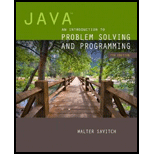
Explanation of Solution
Modified last loop in Listing 7.8:
The last loop in Listing 7.8 is modified by using “for” loop with method “getNumberOfEntries” which is given below:
/* Compute the number of entries in the list using method "getNumberOfEntries" */
int count = toDoList.getNumberOfEntries();
/* Finally display the number of items in list using "for" loop */
for(int position = toDoList.START_POSITION; position <= count; position++)
//Display the list of items
System.out.println(toDoList.getEntryAt(position));
Explanation:
The modified loop is used to display the each item in the list using method “getNumberOfEntries”.
- • First compute the number of entries in the list using method “getNumberOfEntries” and store it to an integer variable “count”.
- • Then display the item one by one in the list by using “for” loop.
Complete code after changing the given loop:
The complete executable code for given program after changing the last loop in Listing 7.8 is given below:
File name: “OneWayNoRepeatsList.java”
public class OneWayNoRepeatsList
{
//Refer the textbook Listing 7.9 of chapter 7.
}
File name: “ListDemo.java” (Listing 7.8)
//Import required package
import java.util.Scanner;
//Define "ListDemo" class
public class ListDemo
{
//Initializes required variable
public static final int MAX_SIZE = 3; //Assumed > 0
//Define main function
public static void main(String[] args)
{
//Create object "toDoList" from "OneWayNoRepeatsList" class
OneWayNoRepeatsList toDoList = new OneWayNoRepeatsList(MAX_SIZE);
//Prompt statement for user
System.out.println("Enter items for the list, when prompted.");
//Initializes Boolean variable
boolean moreEntries = true;
//Assign string variable
String next = null;
//Create object for scanner class
Scanner keyboard = new Scanner(System.in);
//Read an item from user
while (moreEntries && !toDoList...
Want to see the full answer?
Check out a sample textbook solution
Chapter 7 Solutions
Java: An Introduction to Problem Solving and Programming plus MyProgrammingLab with Pearson eText -- Access Card Package (7th Edition)
- Capsim Team PowerPoint Presentations - Slide Title: Key LearningsWhat were the key learnings that you discovered as a team through your Capsim simulation?arrow_forwardWrite the SQL code that permits to implement the tables: Student and Transcript. NB: Add the constraints on the attributes – keys and other.arrow_forwardDraw an ERD that will involve the entity types: Professor, Student, Department and Course. Be sure to add relationship types, key attributes, attributes and multiplicity on the ERD.arrow_forward
- Draw an ERD that represents a book in a library system. Be sure to add relationship types, key attributes, attributes and multiplicity on the ERD.arrow_forward2:21 m Ο 21% AlmaNet WE ARE HIRING Experienced Freshers Salesforce Platform Developer APPLY NOW SEND YOUR CV: Email: hr.almanet@gmail.com Contact: +91 6264643660 Visit: www.almanet.in Locations: India, USA, UK, Vietnam (Remote & Hybrid Options Available)arrow_forwardProvide a detailed explanation of the architecture on the diagramarrow_forward
- hello please explain the architecture in the diagram below. thanks youarrow_forwardComplete the JavaScript function addPixels () to calculate the sum of pixelAmount and the given element's cssProperty value, and return the new "px" value. Ex: If helloElem's width is 150px, then calling addPixels (hello Elem, "width", 50) should return 150px + 50px = "200px". SHOW EXPECTED HTML JavaScript 1 function addPixels (element, cssProperty, pixelAmount) { 2 3 /* Your solution goes here *1 4 } 5 6 const helloElem = document.querySelector("# helloMessage"); 7 const newVal = addPixels (helloElem, "width", 50); 8 helloElem.style.setProperty("width", newVal); [arrow_forwardSolve in MATLABarrow_forward
 C++ Programming: From Problem Analysis to Program...Computer ScienceISBN:9781337102087Author:D. S. MalikPublisher:Cengage Learning
C++ Programming: From Problem Analysis to Program...Computer ScienceISBN:9781337102087Author:D. S. MalikPublisher:Cengage Learning Microsoft Visual C#Computer ScienceISBN:9781337102100Author:Joyce, Farrell.Publisher:Cengage Learning,Programming Logic & Design ComprehensiveComputer ScienceISBN:9781337669405Author:FARRELLPublisher:Cengage
Microsoft Visual C#Computer ScienceISBN:9781337102100Author:Joyce, Farrell.Publisher:Cengage Learning,Programming Logic & Design ComprehensiveComputer ScienceISBN:9781337669405Author:FARRELLPublisher:Cengage EBK JAVA PROGRAMMINGComputer ScienceISBN:9781337671385Author:FARRELLPublisher:CENGAGE LEARNING - CONSIGNMENT
EBK JAVA PROGRAMMINGComputer ScienceISBN:9781337671385Author:FARRELLPublisher:CENGAGE LEARNING - CONSIGNMENT Programming with Microsoft Visual Basic 2017Computer ScienceISBN:9781337102124Author:Diane ZakPublisher:Cengage Learning
Programming with Microsoft Visual Basic 2017Computer ScienceISBN:9781337102124Author:Diane ZakPublisher:Cengage Learning C++ for Engineers and ScientistsComputer ScienceISBN:9781133187844Author:Bronson, Gary J.Publisher:Course Technology Ptr
C++ for Engineers and ScientistsComputer ScienceISBN:9781133187844Author:Bronson, Gary J.Publisher:Course Technology Ptr





